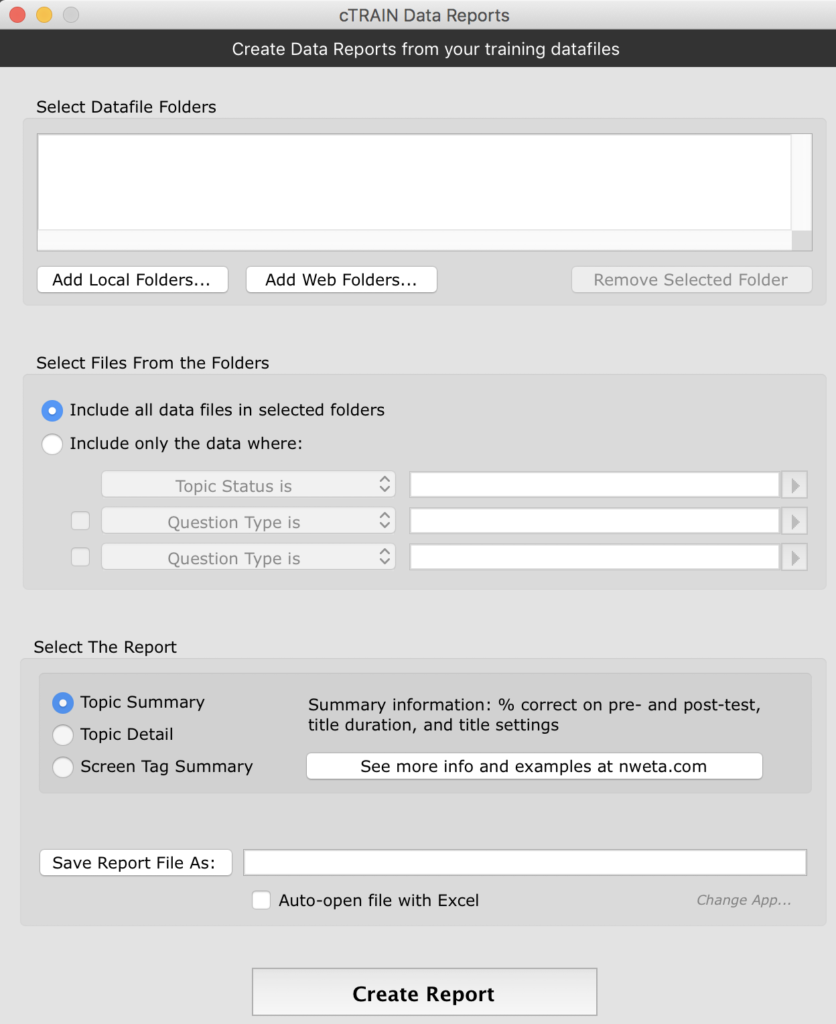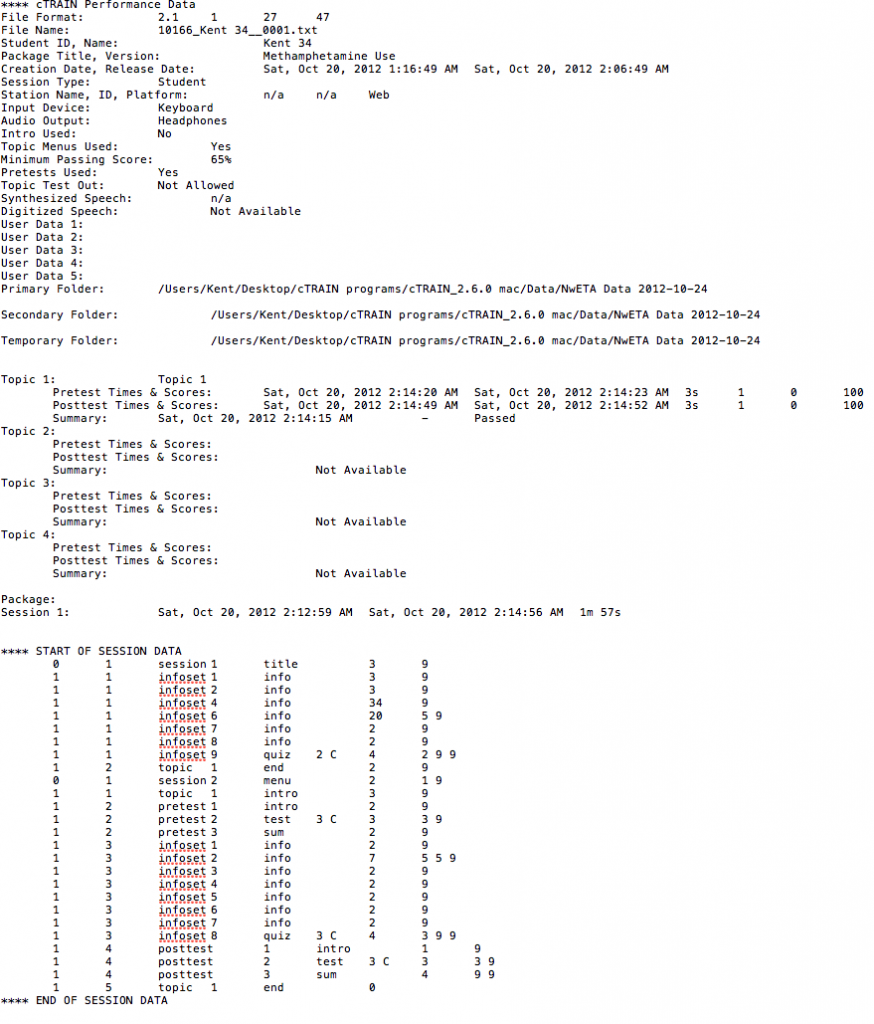To create a spreadsheet with data from your cTRAIN title, take these steps on your desktop:
Click to download Data Reports (free) for Mac or Windows. >>>
- Enter your Account ID and password (email NwETA from the email address the title is registered under for this information)
- cTRAIN Data Reports opens with this window:

- Click:
- “Add Web folders” for data from web delivery or
- “Add Local folders” for data previously saved on your PC (only needed for multiple titles), or
- Both “Add” options for web and data on your PC, or select more than one Web-delivered title
- Make choices for File Selection (Include all data files is an easy choice)
- Under Output Description, click to select your Output File Location (where you will also name your file)
- Select the Report Type *
- Check “Auto-open file with Excel
(click “Change App” to select other spreadsheet options) - Click Create Report
Your spreadsheet will open.
————————
* Report Type
There are three types of report as shown in the picture to the right: Topic Summary, Topic Detail, Screen Tag Summary. They are depicted below in pictures taken from a spreadsheet generated by cTRAIN’s Data Reports feature.
The Topic Summary and Topic Detail Reports are the same for the first 33 columns of information (seen in the first three pictures or sets of rows below, ending in “Screens Recorded”). Both reports contain basic summary information: % correct on pre- and post-test, title duration, and title settings.
Topic Detail Report also contains a record of the responses on every quiz and test question. The four pictures below list the data for one trainee in a title that contains only one pre-test question, one post-test question, and two quiz questions.
Continuation of the rows above from the Topic Detail Report (same as Topic Summary Report):
Continuation of the rows above from the Topic Detail Report (same as Topic Summary Report):
Continuation of the rows above from the Topic Detail Report. These rows are unique to the Topic Detail Report. They will string out as many pre-test, quiz, and post-test questions you have in your title.![]() In the picture, the first column has “pretest” in the top row and “1” in the bottom row which indicates the number of questions in the pretest. The screen numbers (e.g., 1.2.2) are above the answer for the test/quiz on the screen number (e.g., the trainee chose answer 1 on screen 1.2.2, and it was correct as indicated by the “C”). For screen 1.3.9, the trainee chose answer 2 and it was correct (C).
In the picture, the first column has “pretest” in the top row and “1” in the bottom row which indicates the number of questions in the pretest. The screen numbers (e.g., 1.2.2) are above the answer for the test/quiz on the screen number (e.g., the trainee chose answer 1 on screen 1.2.2, and it was correct as indicated by the “C”). For screen 1.3.9, the trainee chose answer 2 and it was correct (C).
Screen Tag Summary Report = data by categories you must have entered when creating your title (eg, you might have divided questions into basic and advanced information or Background, rules, policies).
Subject Data File (SDF) = a second-by-second listing of every response made by the trainee (subject). You will find this in your Data Folder in cTRAIN. If you download web data, these SDFs will be created in the Data Folder in your desktop cTRAIN software. This is what it looks like:
Description of the SDF format (introduction):
File Format: an internal NwETA code
File Name: Name or ID information entered by the student taking the training or by the website sending information to cTRAIN
Package Title/Version: The title of the training (per the developer). Version numbers a not systematically used and can be ignored.
Creation Date, Release Date: Date the first draft of the title was created in Builder and when it was released for use (the latter has been replaced by when it was uploaded to the web so this is irrelevant information)
Session Type: “Student” is the only type, at present
Station Name, ID, Platform: Web is the only platform
Input Device: Keyboard is the only answer, also standing for an on-screen keyboard on a tablet
Audio Output: “Headphones” is an option; it is for some user instructions to indicate whether or not the headphones screen should be included
Intro Used: Yes or no. The user instructions (low-education, standard, mini) is listed, if used. “No” user instructions used is an option.
Topic Menus Used: Yes or no. If no, topics are presented from 1-4 in order. If yes, the subject can choose the topic order.
Minimum passing score: Is the score set when working in Builder that determines whether the person is logged in as passing the test. It can be changed after training begins, so it may differ among different SDFs.
Pretests Used: Yes/no. There is an account setting that can be set to not present the pretest. This reflects the setting for the SDF participant.
Topic Testout [in the pretest]: Yes (percentage required) or not allowed. Not allowed means the trainee was not allowed to testout.
Synthesized Speech: Yes or na [not available]. Older operating systems provided synthesized speech and cTRAIN had the option of using it. It is no longer allowed in cTRAIN.
Digitized Speech: Not allowed.
User Data 1-5: Not used.
Primary Folder: Location on the computer of the folder where the data were located when the report was generated.
Secondary Folder: Location on the computer of the folder where the data were located when the report was generated. This is required for processing.
Temporary Folder: Location on the computer of the folder where the data were located when the report was generated. This is required for processing.
Topic 1:
Pretest times and scores: Date and time the pretest was begun and completed, number of seconds between when the test was begun and when it was completed, percent correct score on the pretest.
Posttest times and scores: Date and time the posttest was begun and completed, number of seconds between when the test was begun and when it was completed, percent correct score on the pretest.
Topic 2, 3, 4:
Same as for Topic 1.
Package: Titles used to be called “packages.” This will generally be blank.
Session 1: Start date and time, and completion date and time of the training; completion time minus start time in minutes and seconds: 1 minute, 57 seconds.
__________________________
Description of cTRAIN
cTRAIN titles may begin with (optional) user instructions followed by 1, 2, 3 or 4 topics. Each topic begins with a pre-test (which can be excluded by an account setting and is thus optional), followed by one or more infosets containing the training information, and concludes with a posttest. Extrasets, which consist of one or more info screens but no quiz screens, may also be used; they are inserted to provide additional information about a screen but the student does not have to elect to see it – they can ‘not request’ to see the screen(s). Each infoset begins with at least one screen of information (an info screen) and ends with at least one quiz screen (a quiz screen).
————————————–
IN AN SDF, EVERY SCREEN THAT APPEARED TO THE STUDENT DURING THE TRAINING IS LISTED ON A SINGLE LINE IN CHRONOLOGICAL ORDER. IF A SCREEN IS IDENTIFIED in the SDF, IT APPEARED IN THE TRAINING.
———————————————
Dictionary of terms in an SDF
Every screen viewed is listed, in order, on a single line. It lists (left to right):
• the topic number
• the infoset number [except user instructions which is listed as infoset 1]
• session/topic/pretest/infoset/posttest [“infoset” should be read “screen”] number
• the type of screen [title, info, quiz (multiple choice question at the end of each infoset), end, menu, intro [first screen in an infoset], test [pretest or posttest], sum [results of a pretest or posttest]
• number of seconds the screen was visible until the 9 was pressed
• every keyboard response while viewing the screen, invariably ending with a 9 [next] response [unless the student closed the browser/computer].
Quiz or test questions have two additional entries before the seconds entry:
• the number of the correct answer (1, 2, 3 or 4]
• “C” [correct] or “I” [incorrect] – so in a correct response the correct answer number will be the same number as the last key press before the 9 response (remember that trainees can press the 4 various answer response keys [1-4] without penalty – except the last key pressed before the 9 must be the correct answer number).


The 9 response options are shown above – 1-4 are for answers to quiz or test questions, 5 is to show a video or a popup picture (for large pictures), 6 is to have cTRAIN speak the screen, 7 is to transition to extraset or “more” screen(s), 9 is to move to the next screen.
—————————————————-
SDF example continues:
**** START OF SESSION DATA
0 1 session 1 title 3 9: The “session 1” is defined as the beginning screen of each topic (topics include the user instructions). The “Title” is the type of screen. When training begins, it is the sign-in screen (unless the subject is sent by a link to the user instructions or the title screen in which case this line won’t appear). In the above case the training began with user instructions. The time viewing the screen was 3 seconds and the only response made was a 9, the “next” response to move to the next screen.
1 1 infoset 1 [screen] info 3 9: Indicates Topic 1 [user instructions] screen 1 (irrelevant) Infoscreen [infoset in this column always means screen] number of the grouping of screens. “info” indicates the type of screen. Time on the screen was 3 seconds, 9 [“next”] response to exit screen.
1 1 infoset [screen] 1 info 3 9: Topic 1 [user instructions] infoset [screen] 1 info [type of screen] 3 sec [time on screen] 9 [“next’ response to exit screen
1 1 infoset [screen] 2 info 34 9: Topic 1 [user instructions] infoset [screen]



